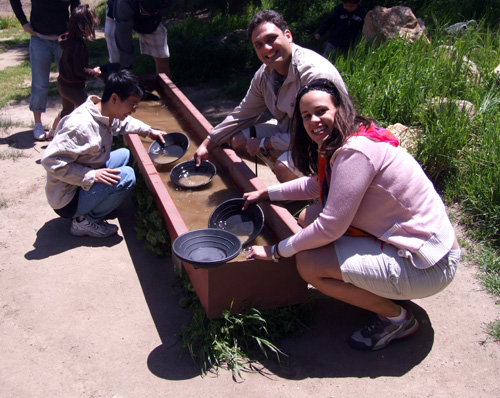
Photos and story by Donald H. Harrison

JULIAN, California – The 90-minute Smith Ranch train and gold mine tour serves up nuggets of history, Smith family lore, and some miners’ “gold.” This last Saturday, along with three international visitors and my 10-year-old grandson Shor, I found the well-planned, well-choreographed outing to be both educational and enjoyable.
The ranch can be accessed from the rear parking lot of the Mormon Church on State Highway 78 about a mile east of the commercial area of this San Diego County mountain town. The Smiths are active members of that church, and arrangements have been made for cars to park either in the church’s paved lot, or in the field near the ranchers’ windmill. The tour costing $15 for adults and $12 for children is available several times a day Mondays through Saturdays, but it is not offered on Sundays. That’s when the church holds its services.
From the windmill area, where the single chemical toilet available to visitors is located, tourists are taken four-to-a-car on an 18-inch narrow-gauge railroad to the entrance of a mine which, when it was dug in 1870, was known as the Three Brothers Mine. Greg and Lisa Smith have owned the property since 1991 and the family slowly has been removing more than a century’s worth of dirt and silt that has rendered the mine non-functional except as a visitors’ attraction.
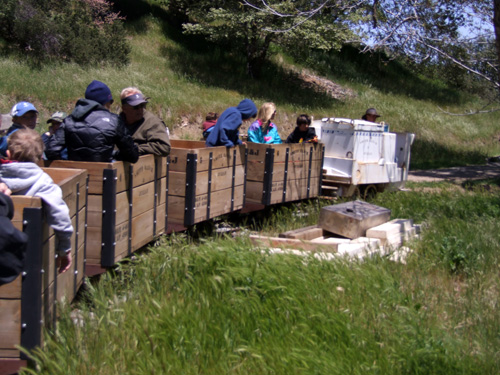
The train is powered by a battery weighing 2,500 pounds. “If you put it in your car, you’d smash it.” said Greg. He meant the car, not the battery. He said he chose the massive battery rather than a more conventional steam- or gasoline-powered engine, so as not to pollute the air of the mine. As for the narrow gauge of the railroad track, he said, it makes it easier for the train to negotiate sharper turns.
Once visitors climb into the train’s small, open-air, wooden cars, they may be joined by “Honeydog,” the Smith family pet that likes to ride the rails. She climbed into the car that I occupied along with Shor and Dat Duong from Da Nang, Vietnam. Our other visitors, Vitor and Roberta Moraes from Macaé, a small mountain town in Brazil about 120 miles from Rio de Janeiro, rode (with human company) in the car in front of us.
Honeydog snuggled under one of the blankets that Greg thoughtfully provides for passengers, as it can blow up a breeze on them ‘thar hills. She then slept on Shor’s feet all the way up to the mine. Originally the dog’s name was simply “Honey,” but, according to Greg, it was decided to change it after Lisa realized that both the dog and her husband were answering when she called that name.
Along the train’s route, Greg stopped to tell about local flora and history, his informative narration somewhat hampered by the lack of speakers and microphone. Pointing out a manzanita tree – its name derived from a Spanish word meaning “little apples” — he informed passengers that its berries are edible. Other trees along the winding, climbing train route included crab apple, cedar and American chestnut.
In the times before the 1870’s mining boom, Smith told us that the Julian area had been transited by two great expeditions – that of Spanish explorer Juan Bautista de Anza in 1774 and that of the Mormon Battalion in 1846. He reported that the Mormon Battalion’s guide, Jean Baptiste Charbonneau, was the baby born 41 years earlier to Sacagawea, the Indian woman who had guided the famous Lewis and Clark expedition through the Pacific Northwest.
Another bit of history was far more local. Stopping the train on a small bridge, Smith said it was named the “Sweetheart Bridge” because it was there that his son-in-law had proposed marriage to his daughter.
The train also passed a 45-star U.S. flag, which had been in use until 1908, and an 1898-cannon of the type used in the Spanish American War. The flag and cannon are part of what will become “Fort Daniel Boone” on the ranch property, named for the famous explorer who was a many-generations-great-uncle of Greg’s. Besides offering tours, Smith Ranch offers camping experiences. There’s even a dry-land boat to teach campers the difference between the bow and the stern, port and starboard. And what use is the old cannon? “Isn’t that the way everyone gets rid of gopher problems?” he joked.
When the railroad reached the entrance to the mine, Honeydog lumbered out of the car and, after waiting for the group to find comfortable seating nearby, she picked out a Cub Scout from a Rancho Santa Fe pack upon whom to lavish her attention—sleeping by the lad’s feet. Later she took a drink and a swim in a pond.
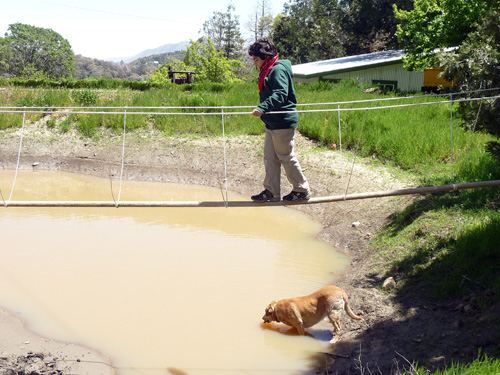
Sometimes, Greg Smith noted, it gets a bit chilly in Julian, especially in February – which was the month that Julian’s first mine was discovered in 1869. It was February 22nd, to be exact, which is George Washington’s birthday, and thus the first mine in the area was named the Washington Mine.
Greg said that right around that date in a recent year, he was talking to his son in Idaho and complained that the weather in Julian had dropped to freezing: 32 degrees. There was a pause on the Idaho side of the line, and the son responded, “Dad, it’s minus-32 degrees here!”
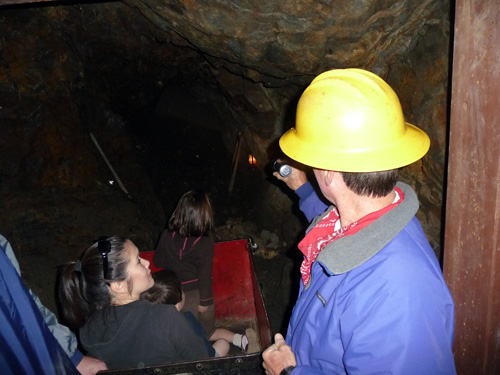
During the 1870’s, when the Three Brothers Mine was active, the train traveled from the interior of the mine down a slight grade toward the entrance, Greg said. However, before the train reached the entrance, the grade started rising, creating a shallow pit for the train to negotiate. Question: Why was the grade downhill from the mine? asked Greg, a former algebra teacher. Answer: to enable the train to take advantage of gravity while hauling tons of potentially ore-bearing rock from the mine to the surface. Also, to allow any water that might leak into the mine to run down to the entrance. Question: Why have a pit just inside the entrance? Answer: to slow the train down before it emerged from the mine. Question: What about any water that accumulated in the pit? Answer: A pump was installed to keep the pit dry.
The mine owner held up a piece of sedimentary rock known as “Julian schist” and a piece of quartz, and explained that the quartz often became lodged in the cracks of the Julian schist. After extracting the quartz, miners would pound it into pebbles and dust, and then wash it in a pan while looking for tiny pieces of gold.
After distributing hard hats, he led small groups perhaps 20 to 30 feet into the dark mine, shining a flashlight on spots where he found an old pick and other miners’ artifacts. Retracing their steps, the visitors were led to a trough of water where the sand had been salted with “gold colored” nuggets – not real, but fun to pan anyway. The “gold” then could be taken to the Smith operated “trading post,” where the nuggets could be redeemed for pieces of red licorice.
Visitors also were shown how to prime an old water pump by pouring water into the top of it. My grandson went about the task with enthusiasm, prompting me to wonder if I ever had seen him work so hard. Those so desiring also had the opportunity to traverse a pond on a rope bridge, to taste “miner’s lettuce,” an indigenous, edible plant, and to heft two bricks—one an ordinary fireplace brick, the other a smaller, but heavier brick of lead. Because of its greater density, gold is even heavier than the lead, Smith said.
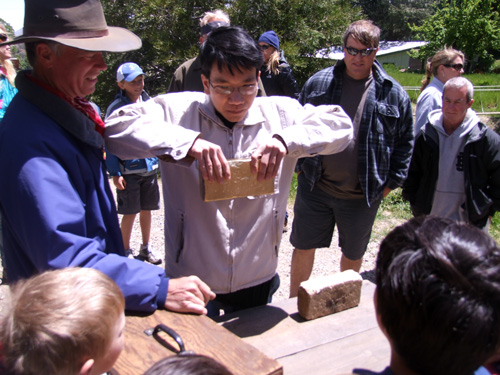
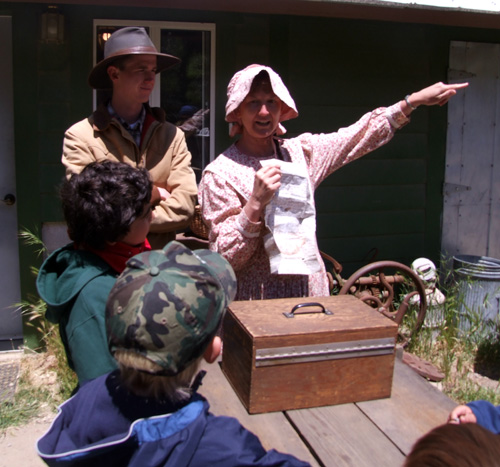
Outside the trading post, Lisa Smith read a letter that her great-great grand uncle had written in 1849 from the steerage compartment of a sailing vessel that was taking him from New Orleans to Panama, en route to the California gold fields. The Ohio native said that around him many men were playing cards, while another man sawed on a violin to little musical effect. The 49er had covered his letter with writing on both sides, and even had turned the paper sideways to get still more words onto the paper. Question: Why did he do this? Answer: Paper was very scarce and very expensive, so correspondents got the most onto the paper that they could!
Postage was also very expensive, and in those days it could take a month or more for a letter to reach its destination, added Lisa, who was costumed in a bonnet and 19th century dress. A couple of decades after the 1849 Gold Rush, the Pony Express was established, and its mail service was quicker. Although Pony Express Riders carried mail, they didn’t carry gold in their pouches. Question: Why not? Answers: They might get held up by bandits, and gold bricks were too heavy to carry.
All in all, I found the tour quite informative and well choreographed. Adding sound equipment on the train, lights in the mine, and a restroom near the trading post would further enhance a fine experience.
Vitor had quite a poignant take on the tour. Married just two years and thinking of having children, he said he was impressed by how the Smith family lives and works together even in the modern world. For him and for Roberta, he said, “5000 miles away from our families, it is very important to see how valuable it is to be with family.”
*
Harrison is editor of San Diego Jewish World. He may be contacted at donald.harrison@sdjewishworld.com